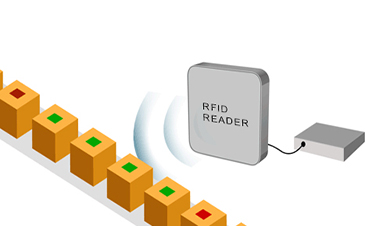RFID intelligent production uses novel, comprehensive, advanced and intelligent production management to collect data through various technologies of the Internet of Things. RFID automatic induction acquisition technology realizes the inventory of materials, transportation, product inspection, especially the process control of the production process, and optimizes the efficient management of the entire production line. The application of RFID technology in production control realizes the visualization and intelligence of the production line. RFID opens a new chapter in the field of intelligent manufacturing.
In the traditional manufacturing industry, RFID electronic tags have many advantages over the currently widely used bar code technology. The advantages of RFID electronic tags include:
simultaneous reading of multiple tags; wireless long-distance reading and writing; penetrability reading and writing; reading and writing in high-speed moving state; storing more data information; in harsh environments Use below. RFID technology is not just a simple replacement of bar code technology, its application in manufacturing will change the way of manufacturing operations. RFID technology has begun to be applied to supply chain management, warehouse management, material management, etc. in the manufacturing industry.
The visualization of the production line enables the management of the company to discover the operating status of the raw products and production lines in real time. The system is mainly composed of assembly lines, RFID data acquisition systems, work-in-progress and workstations. After the raw product moves on the assembly line, the worker removes the recycled product and assembles the spare parts after the work station is completed. After the completion, the return line is placed until all the processes are completed. The system mainly includes two fixed RFID readers. Each product is tagged with an RFID tag.
RFID production control process: When the in-progress product with the RFID electronic tag passes through the RFID reader A and the RFID reader B in sequence, the RFID reader will read the RFID electronic tag information on the product and The data is uploaded to the system host computer to determine the completion of the raw products and the operation of each station. When the raw product passes through the RFID reader antenna A without passing through the RFID reader antenna B, it indicates that the product bound by the label is too long. The system
will compare and alert according to the time set in advance.
In the raw product monitoring, the RFID electronic tag data on the raw product is obtained in real time to determine the work station where the product is located and the completed process.
Assuming that there are N processes in the production line of a certain product, the monitoring method of the production status of the raw products is as follows:
1. When the raw product is put on the line, according to the manufacturing requirements of the raw product, determine the number N of processes, and determine the order of the stations (123…n) to generate a binary code, which is the order of the lowest order. The completion status of the bit, completed as 1, and not completed as 0. When the work is on the line, its initial value is 0.
2. Write the code to the RFID tag and bind it to the product.
3. Modify the corresponding bit code every time the raw product completes the process and leaves the station.
4. Read the corresponding code of the RFID electronic tag to determine the completed process and the process being completed.
The goal of production process control is to statically or dynamically determine the assembly route and assembly method of the raw product based on the raw product information. The basic
principle is: real-time detection of the assembly route and assembly according to the control system after the raw product information is detected. Way, generate path selection instructions and
assembly prompts. The system is mainly composed of RFID data acquisition system, station controller, kanban and path selection actuator.
The assembly route of the in-process product can be either a static route that is established before going online, or a dynamic route that is temporarily changed after going online. Using the
concept of “virtual production line”, each virtual product is assigned a virtual production line. A virtual line is generated according to the assembly requirements of the raw product. Bind the live
product code and the virtual production line in the RFID tag and then bind the tag to the product. When multi-path selection is made in the raw product, the reader reads the product code in the
tag and determines the next station based on the information in the virtual line. The advantage of this algorithm is that when it is necessary to change the manufacturing process of the raw
product, it is only necessary to change the virtual production line and the work position relationship stored in the controller to facilitate the dynamic control of the assembly path.
In the field of intelligent manufacturing, RFID technology realizes intelligent management and control of production processes and traceability, production tracking and counting. In the
manufacturing process management of manufacturing, thereby improving the visibility and controllability of the manufacturing process of the workshop and increasing the production efficiency
of the enterprise.

